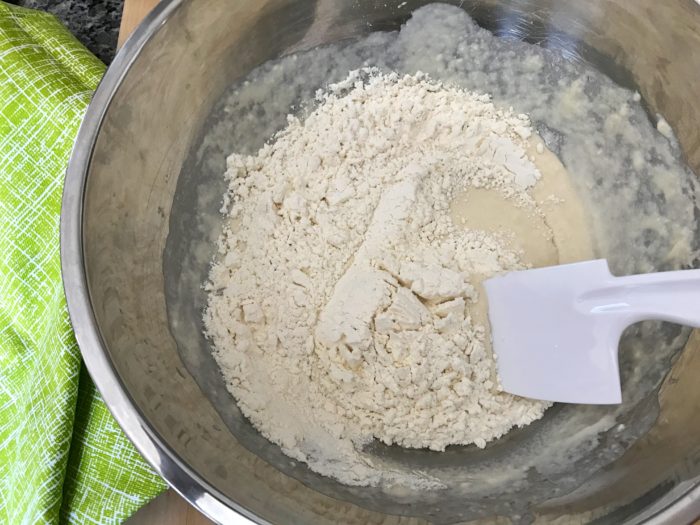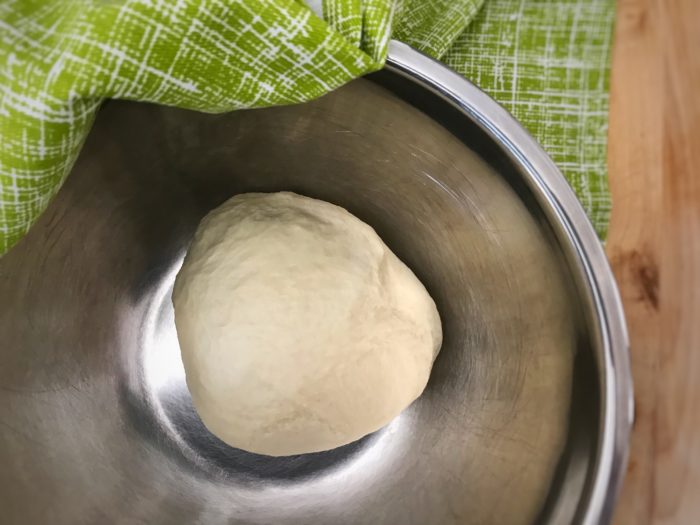I started making pizza dough at home one day when the kids really wanted pizza for dinner and didn’t have anything frozen in the house. I found a basic recipe online that day, and we’ve pretty much had home-made pizza since. It’s cheaper, healthier, and everyone gets exactly what he wants. (Translation: no dinner-time whining. Bonus.)
I’ve tweaked the original pizza dough recipe over the years to make it quick and simple. You can start this recipe and have the finished pizza on the table in 30 minutes. You can also make it ahead of time and keep it in the fridge for a few hours or the freezer for a few weeks. It doesn’t require expert kneading abilities or special tools. And it’s kind of foolproof. I need recipes to be reliable!
The whole recipe is just 6 ingredients which you’ll dump together. I generally use unbleached all-purpose flour. You can use whole grain, just use a little less than the total amount listed in the recipe. The pizza dough will become crumbly and dry much quicker with whole wheat flour.

Start by combining 1 cup of flour with the rest of the dry ingredients. You can make the whole dough in one bowl, so use a large one. Next, add the wet ingredients. (The water shouldn’t be too hot or too cold. It should feel very warm but not so hot that you pull back when you stick your finger in it. There’s no need to measure the temperature. Remember, this recipe is meant to be quick and easy.) As far as the oil goes, I personally prefer vegetable oil over olive oil, but that’s just a flavor preference. Either one will work just fine. Stir everything with a spatula until combined.

Next, add the second cup of flour. It’s time to get your hands dirty. Start mixing the dough with your hands until it comes together into a sticky ball. You’ll need to knead this ball for 2-3 minutes until it’s smooth and elastic. If the dough remains too sticky to handle, slowly add a little bit of the remaining 1/4 cup of flour at a time. You don’t need to use the entire 1/4 cup; only use as much as is needed.


After a few minutes the dough should come together nicely and look smooth and elastic, and the bowl should look almost clean. The dough might still feel sticky to the touch, but it shouldn’t stick to your whole hand.

At this point if you plan on freezing the dough, just flatten it out a little and put it in a freezer bag. Label it with the contents and date, and the dough can be kept frozen for 2-3 weeks. When you plan on using it, move it from the freezer to the fridge a few hours before you’ll need it.
To use the dough the same day, split it in two on a floured surface. (I use a silicone pasty mat like this one.) Roll the first half of the dough into whatever shape you like (round, square, rectangle, unrecognizable abstract – whatever suits your fancy). Put the dough on a cookie sheet lined with parchment paper.

If you’re prepping the dough to use in a few hours, put a second piece of parchment paper on top of the dough, roll out the second half of dough, and put it on top. Then add a third piece of parchment paper and put a second cookie sheet on top of the whole thing. The dough will expand and grow because the yeast is doing its thing. You don’t want big, bubbly pizza dough. The second cookie sheet will weigh things down. Put the whole thing in the fridge until you’re ready to use it.

When you’re ready to use the dough, I would suggest baking it without the parchment paper and putting it directly onto the cookie sheet (you can spray the cookie sheet with some non-stick vegetable oil if you want, but if you bake the pizza adequately, you won’t need it). It will give you a crispier crust. If you prefer doughier pizza crust, you can leave the parchment paper in place.
Top your pizza whichever way you like, and bake it in a preheated 425 degree Fahrenheit oven for 12-15 minutes. You can also cook your pizza on the grill, which will give any brick oven pizza a run for its money!




